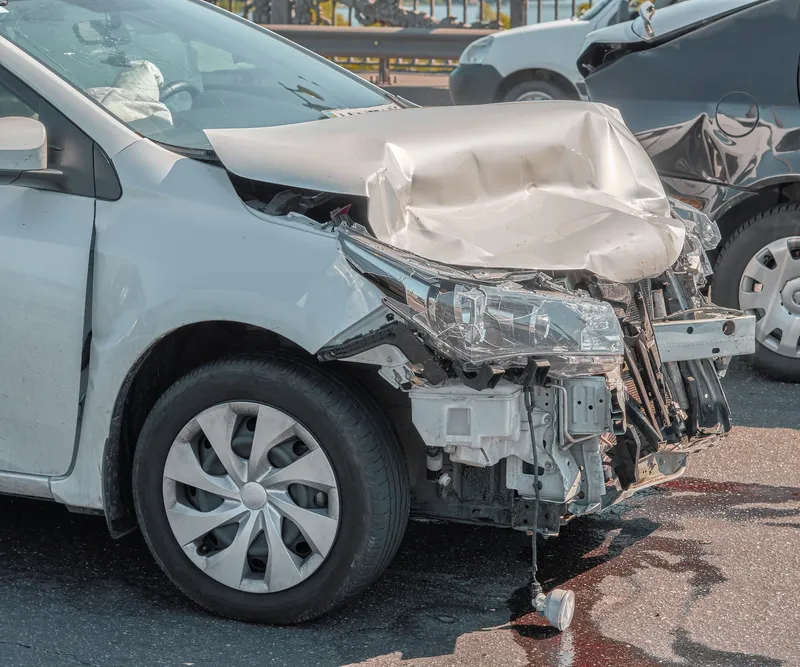
We are often asked what are the common injuries after being rear-ended.
If you were recently injured from getting rear-ended while stopped, you should speak with an attorney to discuss your injuries.
Our firm offers free consultations and will hear your story about your rear-ended collision injuries.
While car accidents happen in a variety of ways, most occur when one vehicle crashes into the back of another.
Around 29% of all car crashes are rear-end collisions. These collisions, where one vehicle strikes the rear of another, are the most common type of crash on the roads. They can result in significant injuries, including fatal ones.
In fact, according to the National Highway Traffic Safety Administration (NHTSA), about one-third of all auto collisions in 2019 were rear-ended accidents.
Around 595,000 of these crashes had a reported injury, while 2,346 of them involved a fatality.
From this, it’s clear that getting rear-ended while stopped is particularly dangerous compared to other accident types.
You can consult with a collision attorney after being rear-ended to get started on your collision claim. Our lawyers created a car accident guide to help you in this situation.
If you’re involved in a car accident where you were rear-ended while stopped, you have rights to seek compensation for various damages, including medical expenses, lost income, vehicle repairs, and emotional distress.
Tawney, Acosta & Chaparro P.C.’s Texas and New Mexico auto accident lawyers are experienced in assisting victims of rear-end collisions, ensuring they receive the full compensation they deserve.
Contact us online or call (575) 222-1000 today for a free consultation.
I Rear-ended Someone Who Stopped Suddenly. Who’s at Fault?
If you rear-ended someone who stopped suddenly, you might argue that the other driver was at fault. Sudden stops without reason can shift the blame.
Here are some factors to consider:
- No Apparent Reason: If the driver ahead stopped abruptly without any clear cause.
- Unsafe Conditions: The stop created a hazardous situation.
- Traffic Violations: The other driver violated traffic laws by stopping suddenly.
Who Is at Fault When Rear-Ended While Stopped?
Typically, the driver who rear-ends a stopped car is considered at fault in such accidents.
Regardless of whether the front vehicle stopped suddenly or for other reasons, the responsibility for the collision generally lies with the driver who fails to maintain a safe distance or fails to react appropriately to the stopped vehicle.
In Texas, a driver brake-checking without justification in a rear-end accident may be held liable. Dashcam footage or witness testimony is often crucial to establish fault.
What Is the Cause of Most Rear-Ended Collision Injuries?
The cause for most rear ended collision injuries can vary, but we wanted to list a few in which our law firm has come across.
Much like any auto accident, there are several conditions that cause rear-end crashes. However, most occur when the driver in the front slows down or stops, and the driver behind them isn’t prepared.
With this in mind, most rear-end accidents, and common injuries from being rear ended happen due to:
- Tailgating,
- DUI/DWI,
- Distracted driving:
- Rear end crashes are the most common because of the prevalence of distracted driving. According to a report by the National Transportation Safety Board (NTSB), distracted driving accounts for 87% of rear-end collisions. This type of crash occurs when a driver fails to notice the vehicle in front of them in time to slow down or stop, leading to a collision.
- Poor road conditions,
- Bad brakes,
- Worn tires, and
- Low visibility.
In many of these situations, the driver following behind negligently ignores their surroundings or drives aggressively. This often results in a serious crash, especially if the motorists are traveling at high speeds.
For this reason, more than a quarter of all rear-end collisions result in serious injuries.
What Damage Can a Rear-End Collision Cause?
So, what happens to your body in a rear-end collision? Usually, the force from the impact causes the body to jerk forward without warning.
This is why safety mechanisms like seatbelts and airbags are important. Without them, the victim may hit the steering wheel, dashboard, or windshield with violent force, causing serious injury or death.
However, even though these precautions help prevent life-threatening injuries, they can’t nullify all of the energy transferred to your body from the crash.
As a result, your head, neck, spine, and limbs may whip back and forth, causing soft tissue injuries or worse.
If the impact is strong enough, these safety precautions may fail, leading to a severed spinal cord or serious organ damage.
Most Common Injuries from a Rear-End Collision
Whether a rear-end accident happens at low or high speed, the chance of an injury is significant.
While these injuries range in severity, they all result in a painful or difficult healing process.
Here are some of the most common injuries from a rear-end collision and their symptoms.
Whiplash
Being the most common injury in a car accident, it’s no surprise that whiplash poses a huge problem in rear-end crashes.
This injury occurs when the soft tissues in the head, neck, and shoulders strain or tear due to excessive movement.
Symptoms of whiplash from a rear-end collision typically include stiffness, pain, weakness, numbness, and headache.
Spinal Injuries
Back injuries, particularly those involving the spinal cord, are among the most severe.
When the human spine takes more pressure or stress than it’s meant to withstand, it may fracture vertebrae or cause herniated discs.
In severe cases, this may result in paralysis of the lower limbs. It might also cause other symptoms like weakness, numbness, nerve pain, or pressure throughout the body.
Traumatic Brain Injuries
Almost all impacts or sudden movements of the head cause a traumatic brain injury (TBI).
Perhaps the most common is a concussion, which occurs when the brain hits the inside of the skull.
While this may not seem serious at first, concussions can lead to cognitive issues, confusion, loss of balance, behavioral changes, and uncontrollable drowsiness.
Among all long-term injuries from rear-end collisions, traumatic brain injuries (TBIs) are some of the most unpredictable and severe.
What to Expect After Being Rear-Ended
After a rear-end accident, we highly recommend seeking medical attention as soon as possible because all of the common injuries from being rear-ended could result in serious injuries.
Some injuries don’t present symptoms at first, even if they’re serious, so it’s better to be safe than sorry.
When examined, you can expect several diagnostic tests such as X-rays, CT scans, etc.
After you receive a diagnosis, your doctor may prescribe medication for inflammation and set up a rehabilitation plan, especially if you have neurological or physiological symptoms.
Injured in a Rear-End Accident? Contact our Rear-End Collision Attorney Today.
At Tawney, Acosta & Chaparro P.C., we know that rear-end collision injuries often result in tremendous consequences for the victim.
Whether you need help negotiating with the insurance company or finding the right treatment, we’re here to help.
With decades of combined trial experience, our rear-end collision attorneys always fight aggressively for our clients’ physical, emotional, and financial wellbeing.
To schedule a free, no-obligation consultation, please reach us online or call (575) 222-1000 today.
We proudly serve clients throughout the states of New Mexico and Texas.

